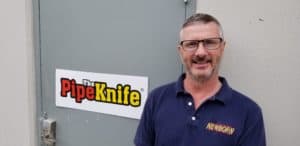Prior to 2019, The PipeKnife Company, a manufacturer of auto glass repair and construction tools, made a fraction of its sales through ecommerce. That changed in 2019, when the company acquired Planned Products, a manufacturer that did 40% of its business through ecommerce.

Dell Skluzak, CEO, The PipeKnife Company
The acquisition of Planned Products—which makes auto glass defroster repair supplies and equipment it sells on ecommerce sites including its own FrostFighter.com—increased PipeKnife’s total daily ecommerce orders from 20 to more than 200. The huge jump in ecommerce orders, and the corresponding workload to manually process them, forced PipeKnife to “get serious about ecommerce,” according to CEO Dell Skluzak.
The primary goal, Skluzak says, was to find a shipping application that aggregated the orders coming from its websites and online marketplaces to make order processing more efficient.
The problem PipeKnife faced was that each day, it had to download orders through each of its nine ecommerce sites, in addition to orders placed through third-party marketplaces, then manually input all that information into its QuickBooks accounting software.
Processing orders for several websites
Next, PipeKnife personnel copied order data and pasted it into a shipping application to generate labels; they then copied the information, yet again, back into QuickBooks to generate an invoice that included shipping expenses and order-tracking information.
But there was still more to do. PipeKnife staff then manually entered the order-tracking information into the ecommerce site to notify the customer of the shipment. Overall, the process took about 30 minutes per order, too long to efficiently handle PipeKnife’s new daily order volume.
In addition to its order-processing issues, PipeKnife needed to process orders for palletized LTL (less-than-truckload) shipments, which accounted for about 30% of its orders. The remaining orders were shipped as parcel packages. The split between how PipeKnife shipped LTL and other orders made it difficult for it to obtain the best shipping rates.
“We get orders through our own websites, eBay, Amazon.com, in addition to phone orders, and we needed a more efficient way to bring all that data into QuickBooks,” Skluzak says. “It was critical to find a solution that was flexible and could accommodate the varied distribution platforms PipeKnife required for its existing business and its acquisitions.”
Rate options for parcel and LTL shipments
To solve its dilemma, PipeKnife deployed the Descartes ShipRush shipping platform from Descartes Systems Group, a provider of software-as-a-service for managing logistics in business-to-business and business-to-consumer companies. The ShipRush application is designed to automate the processing of incoming orders from multiple websites, enabling PipeKnife to shop for the best price and delivery options for parcel and LTL shipments. Descartes purchased ShipRush in 2017 for $14 million.
By aggregating order data from its multiple ecommerce channels, PipeKnife, can view orders on a single platform, which is a big help for managing orders from a catalog of about 1,000 SKUs, PipeKnife says. Processing that information now takes about two minutes per order, says Skluzak.
In addition, PipeKnife has increased the number of monthly shipments by almost 50% during peak season without adding any staff to help process orders. Meanwhile, PipeKinfe has added manufacturing staff to help grow its business.
“We no longer have to dedicate someone to enter order data into QuickBooks, which cuts down costs,” Skluzak says.
ShipRush can also generate international shipment documents electronically, which is an added benefit as about 14% of orders received by PipeKnife ship internationally.
PipeKnife also uses the shipping platform to automatically search for the best shipping rates. This capability has enabled PipeKnife to better manage its freight expenses, as the manufacturer can automatically bill more of its freight expenses at the time of invoice.
33% drop in net freight costs
Net freight costs, which consist of total freight expenses minus the portion billed to customers, “are an important key performance indicator to determine our operating efficiency,” says Skluzak. “Our net freight costs decreased by 33% using this solution.”
Parcel and freight expenses, as well as shipment-tracking information from all carriers, are also automatically posted to the customer’s invoice, which has reduced the number of customer calls about that data by about 20%. It has also cut the time in handling customer service calls regarding that information from a range of five to 10 minutes to about one minute or less, says Skluzak.
“Customers like that this information is on the invoice, and it makes us look more on top of our game when it comes to providing this information,” he adds.
Another benefit of integrating ShipRush to QuickBooks is the ability to drill down and see the cost of shipping low-margin items sold through Amazon.com. That information has helped PipeKnife determine which products it is losing money on by fulfilling orders through Amazon.com. PipeKnife has since moved fulfillment of those products in-house, Skluzak says.
Since the coronavirus pandemic hit in March, PipeKnife has generated more efficiency by moving staff that had fulfilled small packages—i.e., items that can fit into an envelope—to a work-at-home environment. These workers, which are able to access all the necessary order and shipping data information through ShipRush, are more efficient because they are focused solely on order fulfillment, Skluzak says.
“We can now ship larger volumes of products without adding shipping or clerical personnel, and handle international order seamlessly,” he says.
Peter Lucas is a Highland Park, Illinois-based freelance journalist covering business and technology.
Sign up for a complimentary subscription to Digital Commerce 360 B2B News, published 4x/week, covering technology and business trends in the growing B2B ecommerce industry. Contact editor Paul Demery at [email protected] and follow him on Twitter @pdemery.
Follow us on LinkedIn and be the first to know when new Digital Commerce 360 B2B News content is published.
Favorite